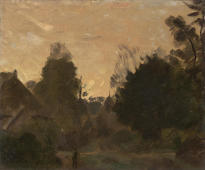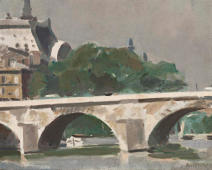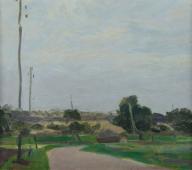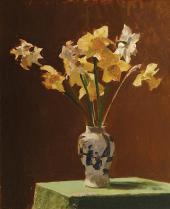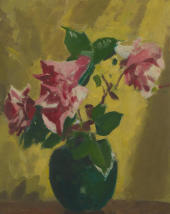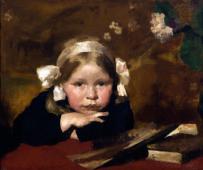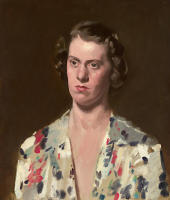Tonalism Art Oil Painting Reproductions
Find Tonalism Art oil painting replicas by Tonalism Art artists
Tonalism Artworks: A Brief Introduction
Tonalism painting was an artistic style that appeared in late 19th century America. From the 1880s onwards, some American artists started painting landscapes and portraits with one overall tone of color. As a result, they often created atmospheric scenes filled with mist and dappled sunlight. This beautiful method of creating art soon spread around the world. Australian artists like Clarice Beckett notably adopted the style during the 1910s, and a second wave of Tonalism artworks emerged.
Here is your essential guide to Tonalism in painting and its most famous artists.
What Does Tonalism Mean in Art?
Tonalism in painting is an Art Historical term that describes paintings focusing on tonal values to communicate mood and feeling. American art critics started using the word “tonal” to discuss artworks in the 1890s. They also used other terms, such as “Quietism” and “Intimism,” to describe soft and atmospheric paintings. The French Barbizon School was an essential inspiration for Tonalism artworks. This art movement emphasizes mood, shadow, painting nature outside, or en plein air. While Tonalism was highly influential during the late 19th century, it petered out with the rise of American Impressionism. Instead of subdued color palettes, American Impressionist paintings embraced a new, brighter approach to art. Despite its demise in America, Australian Tonalism appeared during the 1910s with a group of artists based in Melbourne championing the style.
The painter Max Meldrum founded the Australian art movement, developing a theory of the “Scientific Order of Impressions.” In this theory, Meldrum argued painting should focus on the science of optical analysis. In addition, he thought artists should try to create depth in their works through tonal relationships and shades of light and dark.
Who started Tonalism?
While no single figure launched Tonalism in painting, the artworks of James McNeill Whistler were a massive influence. Whistler didn’t describe himself as a Tonalist artist, but his famous paintings are increasingly associated with the style. James Whistler paintings also use musical terms such as “nocturnes” for his atmospheric creations. This lyrical approach appealed to Tonalism artists, giving extra layers of meaning to their subtle, misty artworks. Whistler’s Nocturne in Black and Gold is one of his famous painting reproductions on canvas. Clarice Beckett paintings, for instance, Moonrise, Beaumaris, show a particular interest in how softness and structure come together. The interplay between modern technology and the natural world, as seen in Passing Trams, 1931, was also striking. Here, the dark trams are only just visible amidst the all-encompassing fog.
Where did Tonalism start?
Tonalism started during the 1880s in America. It was prevalent in California, where artists adored the softly expressive style. Inspired by painters such as James McNeill Whistler and the French Barbizon School, landscape painting was a particular focus.
Tonalism represented a move from the grand American landscape paintings of Albert Bierstadt and Thomas Cole. Instead, artists focused on more intimate scenes of nearby, domesticated environments. George Inness paintings, for instance, Spring Blossoms Montclair, New Jersey c1891 especially show this new approach. Influenced by the Hudson River School, Inness also studied the Old Masters and the new French Barbizon school. This oil on canvas painting demonstrates Inness’s mastery of color, shadow, and light. His complex scenes contrasted precise detail with hazy elements. For example, Inness’s blurry grass and trees contrast with objects in closer focus, including the figure and blossom trees. In the artist’s own words, he showed the reality of the unseen and connected the visible with the invisible. Tonalism also took off in America, and in Australian art, Melbourne-based artists adopted the style from the 1910s onwards. The art movement peaked during the 1920s and early 1930s but continued influencing art well into the 20th century.
What is the difference between Tonalism and Impressionist Paintings?
Tonalism refers to paintings using a limited color palette. This approach usually resulted in compositions favoring grays, blues, and pale tones. On the other hand, Impressionist oil paintings use a vast array of vibrant colors. While tonalists used similar tones in their paintings, Impressionist artists contrasted complementary colors against each other. Pierre Auguste Renoir’s Luncheon of the Boating Party and Claude Monet’s Pathway in Monet’s Garden at Giverny show this approach. These colorful paintings also inspired later Neo-Impressionist techniques such as Pointillism.
In opposition, Tonalist painting uses subtle graduations of color, with paintings focusing on the “middle values” rather than opulent shades. Indeed, Tonalism artists avoid intensely dark or rich tones, an approach used in Renaissance oil paintings by famous artists such as Titian and Caravaggio. Instead, similar shades come together to create shifting, ethereal scenes presenting the essence of a view. Instead of direct representation, Tonalist artworks centered around mood, emotion, and atmosphere. They struck a careful balance between Realism and Impressionism. For this reason, Art Historians sometimes class Tonalism as a transitional style between these two art movements.
What colors does Tonalism use?
Tonalism painting uses a wide variety of colors. For these artists, specific hues weren’t as important as the overall effect. Instead, they favored a subtle range of similar color tones to produce quiet and contemplative compositions. Between 1880 and the early 1910s, Tonalist art has darker, neutral colors with paintings featuring grays, browns, and blues. James McNeill Whistler’s Nocturne in Black and Gold: The Falling Rocket c1875 paintings are clear forerunners of this approach. Australian Tonalism often favors pale and subdued grays, browns, and blues, creating beautiful scenes bathed in light and misty rains.
Who were the Tonalism Artists?
Two famous Tonalism artists are George Inness and James McNeill Whistler. Leon Dabo, Maynard Dixon, and Henry Farrer also painted in the style. Other American artists, such as John Henry Twachtman, Robert Bruce Crane, and Ralph Albert Blakelock, are associated with Tonalism. Nonetheless, their oil paintings often show interactions with multiple artistic styles. For instance, John Henry Twachtman is also associated with the American Impressionist movement. Australian Tonalism painters include Max Meldrum, Colin Colahan, and William Frater. The Australian art movement was notable for its many female artists, Clarice Beckett, Jo Sweatman, and Polly Hurry.
Tonalism Art: Replica Oil Paintings for Sale
Whether it’s the subdued nature of Tonalism reproduction oil paintings or the famous paintings of James McNeill Whistler, explore our extensive collection of 30,000+ replica paintings for sale. Buy oil paintings from George Inness to Clarice Beckett and Leon Dabo and discover stunning fine art reproductions to suit your home or office walls.
Why not take a moment to review photos of finished paintings, customer reviews, and testimonials? Wherever you are, INTERNATIONAL SHIPPING IS FREE.
Cannot Find What You Are Looking For?
Reproduction Gallery Information
Customer Service
(Send Us A Message)
Tel: (503) 937 2010
Fax: (503) 937 2011






